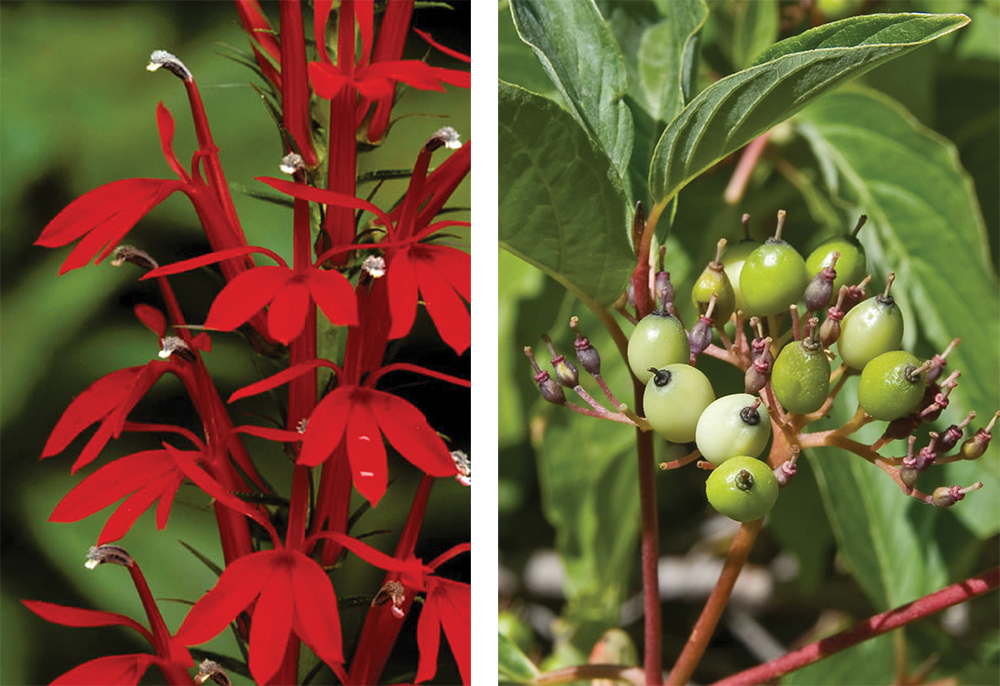Show-stopping native plants
By Jennifer Devine
Current Contributor
Every winter, I find myself falling into a state of dormancy. The cold, darker days are a time of rest for me. A time to recharge, to help us bounce into the next year with vigor.
Dormancy for animals means their normal bodily functions are slowed or suspended for a time, as if in a coma. American bullfrog and wood frog, garter snake, Indiana bat, groundhog, 13-lined ground squirrel, skunk, and American black bear are the only Michigan animals which hibernate.
For plants, dormancy means that they are alive but not actively growing. Deciduous trees and shrubs, some house plants, and outside perennials go dormant. Conifers go through a seasonal change with their needles but are not completely inactive.
As human beings, we might worry that we are “doing too little”or are “brushing people off,” because we would rather lie around the house on a winter’s night. We are lying dormant—resting and waiting for the weather to warm up and the days to get longer. (If you are experiencing seasonal depression, however, please see your medical provider).
So, what am I doing as I wait for spring?
I am reading about native Michigan flora to put in the ground in just a few months. I am seeking vibrant colors.
In this current world of white and gray and black, a splash of color is a welcome thought. Let me share some great ideas for adding red to your garden very soon.
Cardinal Flower
The cardinal flower (Lobelia cardinalis), in the bellflower family Campanulaceae, is an almost-four-foot-tall bright bloomer. The long, wide-middled, lance-shaped leaf (lanceolate) can grow to eight inches long and two inches wide.
Cardinal flowers grow in several Midwest states and grace many home gardens in Michigan’s Lower Peninsula. In the wild, they have been found growing in a nature park in Schoolcraft County in Michigan’s Upper Peninsula. In the Northwestern Lower Peninsula, they have been observed growing along the banks of the Manistee and Platte rivers and in the Sleeping Bear Dunes National Lakeshore. Additionally, Mason County bird researcher and consulting ecologist David Dister reported their presence in Ludington State Park during a 2009-2014 field study, published in The Great Lakes Botanist in 2017.
This brilliantly hued Michigan native flower thrives in damp and waterlogged soils and would be the perfect addition near a downspout, pond, or other continuously wet-to-moist areas. The five-petaled—or lobed—cardinal flower blooms scarlet red but can be found in white and pink from July through September. If you are looking for a showstopper, this is a must.
The Great Lobelia (Lobelia siphilitica), a different species in the same family, blooms bright blue and is primarily pollinated by bees, whereas cardinal flower is mainly pollinated by ruby-throated hummingbirds and some butterflies. Amazingly, the cardinal flower has been used medicinally for hundreds of years but can be potentially toxic. The roots and flowers have also been used by the Pawnee—a Central Plains tribe that historically lived in Nebraska and northern Kansas but today are based in Oklahoma—in a love charm.
Red-osier Dogwood
Speaking of red, you have probably seen shrubs—long, twiggy, and reddish—growing in wet areas and moist roadside ditches, giving stark contrast to the dull grays, browns and white of the winter landscape. The multi-stemmed red-osier dogwood (Cornus sericea) is a deciduous shrub that reaches four to eight feet tall. The shrub spreads rapidly underground by stolons just under the surface. (For reference: Strawberries have stolons above the surface; we just call them runners.) These dogwood stolons form dense thickets and would be great as a wall in the garden, if correctly contained. The colorful plants are currently used to restore banks and reduce erosion in our waterways.
Their leaves are oblong to ovate, being rounded from stem to tip up to four inches long and two inches wide. They are a lush dark-green color on top and a pale bluish-gray to bluish-green underneath, turning red to purple in the fall before dropping in the winter. Leaf texture is silky, which is part of their scientific name: sericea.
The four-to-five-petaled flowers in spring are small, flat, creamy-white, and form in clusters. White berries pop up in late summer.
Found in almost every county in the Lower and Upper peninsulas, the plant is beloved by many animals in all seasons. Bees and butterflies love the nectar, while ducks, birds, and mice enjoy the berries, with their high-fat content. This shrub is also essential to other Midwest wildlife—such as elk, deer, and rabbits—which consume the leaves and munch on the stems. Beavers enjoy putting these stems in their dams.
Meanwhile, Indigenous peoples have used the bitter berries for many medicinal uses that are still in practice today; the inner pith is rubbery and, when scraped, can be used as a tobacco substitute. Additionally, the showy red stems are used in basket weaving, just like willow.
Always use caution and seek guidance when harvesting and using our backyard goodies.
Jennifer Devine has a passion for writing and plants. She has lived in cities and has homesteaded off the grid. She likes to hunt, fish, and forage and meet like-minded people. She is continuously learning, having adventures, and making memories with her family.
A version of this article first published in February 2022 in the Freshwater Reporter, a newspaper based in Manistee and Mason counties.
Featured Photo Caption: The cardinal flower (left), Lobelia cardinalis, is an almost-four-foot-tall bright bloomer. The multi-stemmed red-osier dogwood (right), Cornus sericea, is a deciduous shrub which has creamy-white flowers that turn into white berries in late summer. Both plants are native to the Midwest—in this current world of white and gray and black and brown, a splash of color is a welcome thought. These are great ideas for adding red to your garden very soon. Photos courtesy of the U.S. Forest Service.




